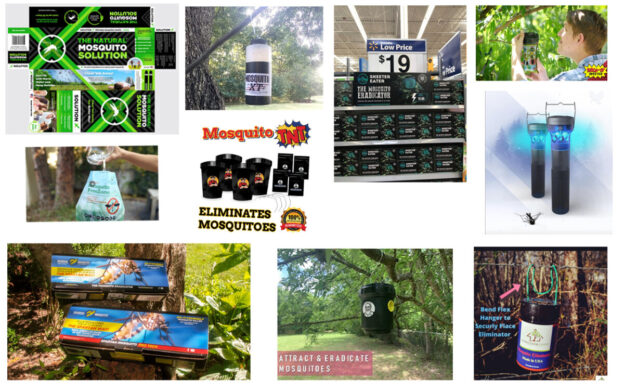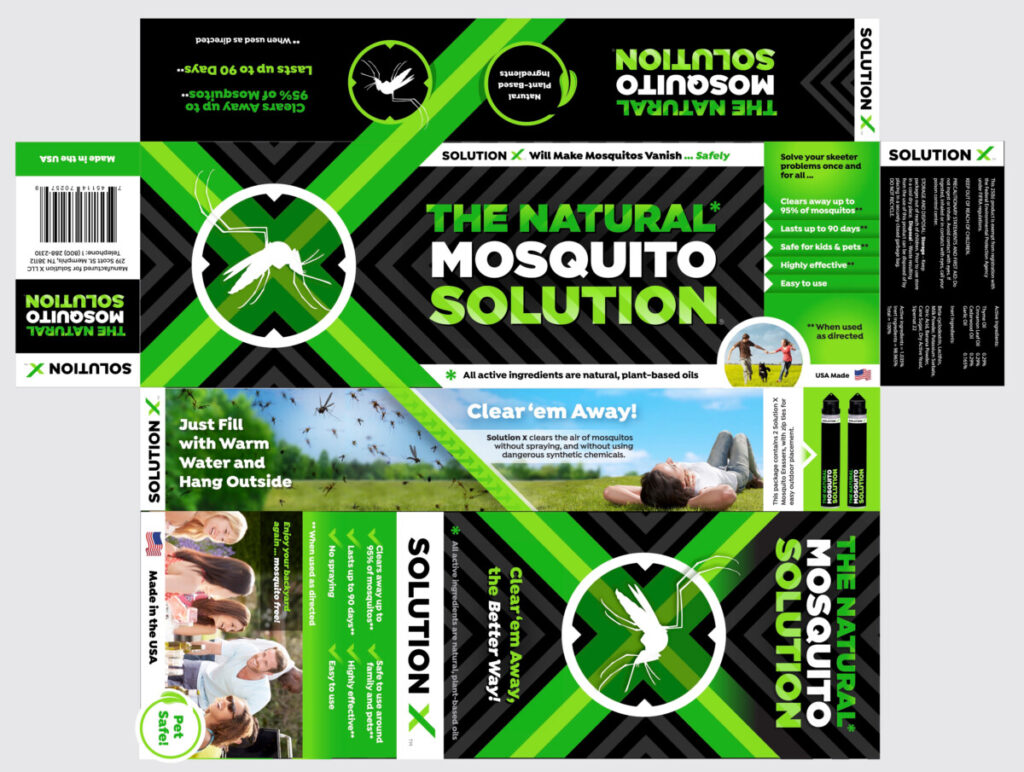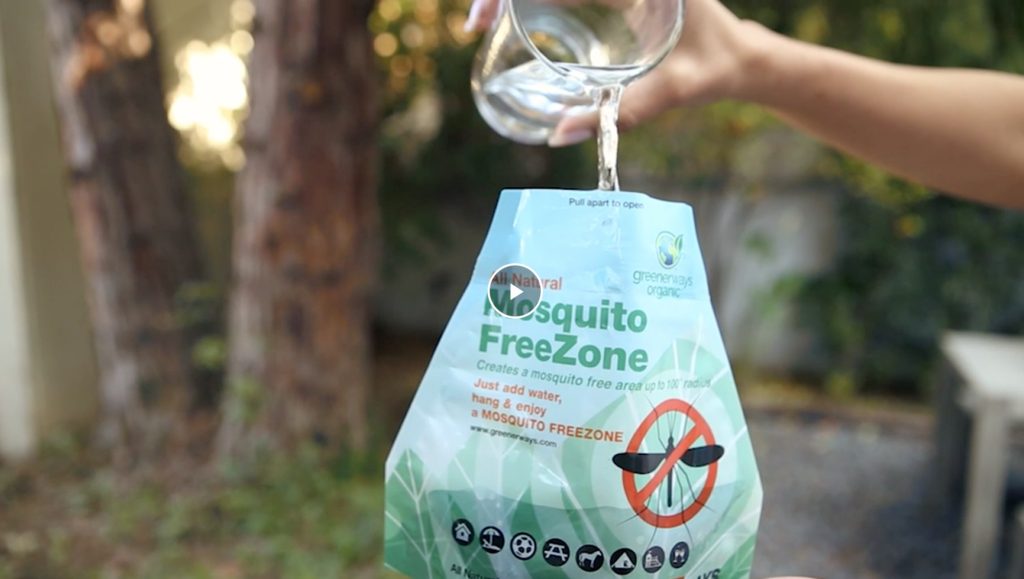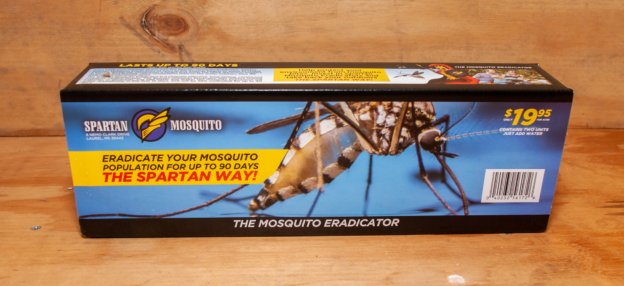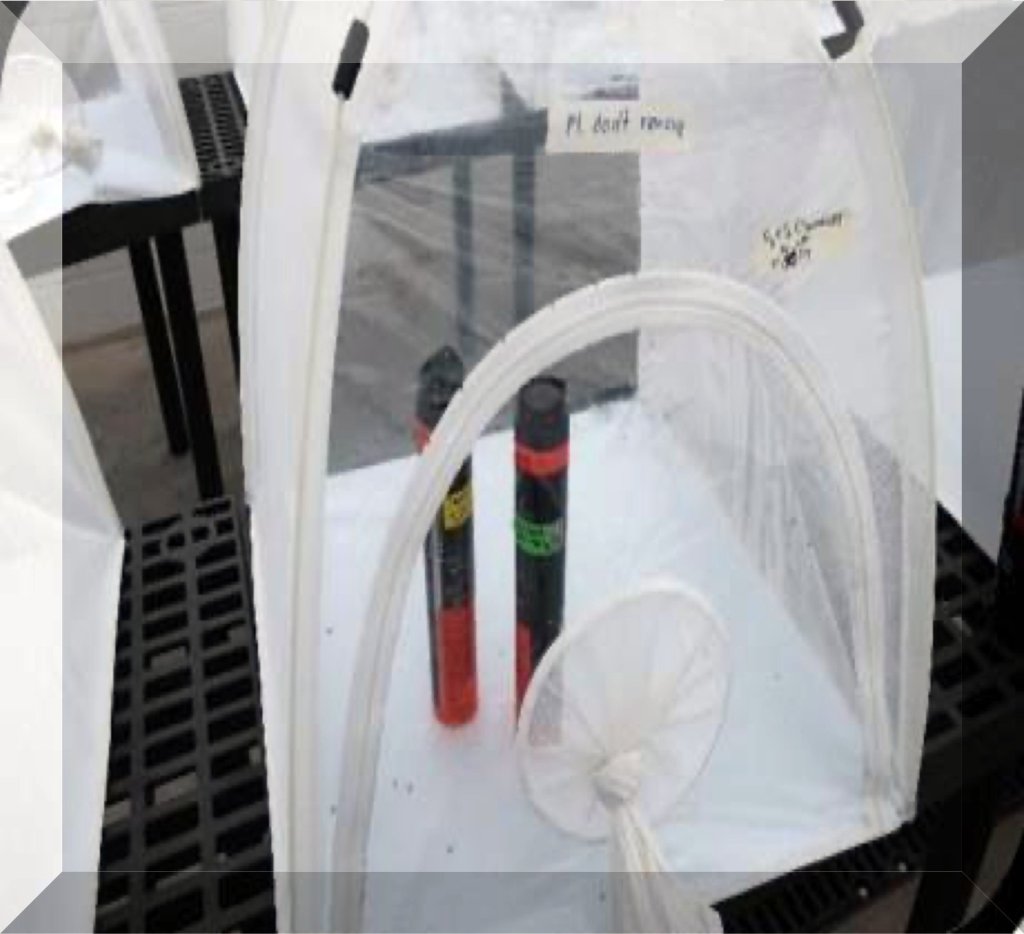In the United States, nine companies are selling containers filled with water, sugar, and yeast for mosquito control. The marketing pitch is that mosquitoes are attracted by carbon dioxide (produced by yeast consuming the sugar), enter the device through holes, crawl inside, ingest some of the fluid, crawl back up to the holes, exit the container, and then die (e.g., by exploding) due to the effects of a chemical (table salt, boric acid, garlic oil, etc.) dissolved in the fluid. Some of the companies claim their tubes will rid a yard of mosquitoes for three months. I summarize the devices below. You can skip to the end if you just want to know whether they work.
1. Spartan Mosquito Eradicator
First sold in 2016 as the Spartan Mosquito Bomb, the company says these tubes will eradicate up to 95% of mosquito population for up to 90 days. Ingredients are sugar, yeast, and salt (purchaser adds water). I reviewed it in 2019. Below is an infomercial featuring Spartan Mosquito’s Chief Chemist, Chris Bonner:
2. Sock-It Skeeter
It’s identical to the Spartan Mosquito Eradicator except it’s a bag instead of a tube. Contains sugar, yeast, and table salt. Made by Spartan Mosquito but listed under a shell company in Florida (details). Here’s one of the commercials:
3. Donaldson Farms Mosquito Eliminator
Like the Eradicator, the Eliminator is marketed to rid yard of mosquitoes for 90 days. Contains sugar, yeast, citric acid, calcium carbonate, salt, and sodium lauryl sulfate. This device doesn’t appear to registered in any of the states that require registration. Based in Chattanooga, TN.
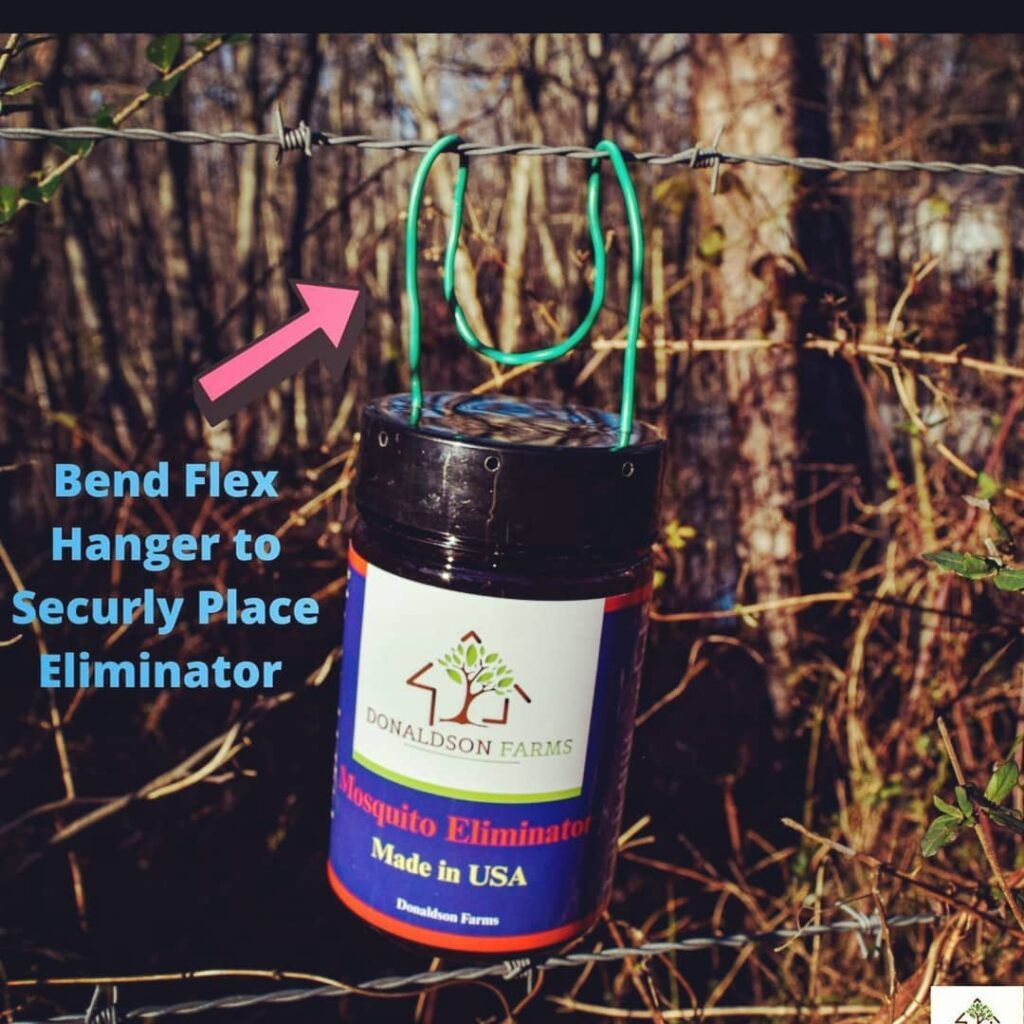
4. Mosquito XT
The Mosquito XT contains sugar, yeast, baking soda, and salt. This device doesn’t appear to registered in any of the states that require registration. Based in Paragould, AR (details), the owners run an insurance agency. Here’s a pic from the website:
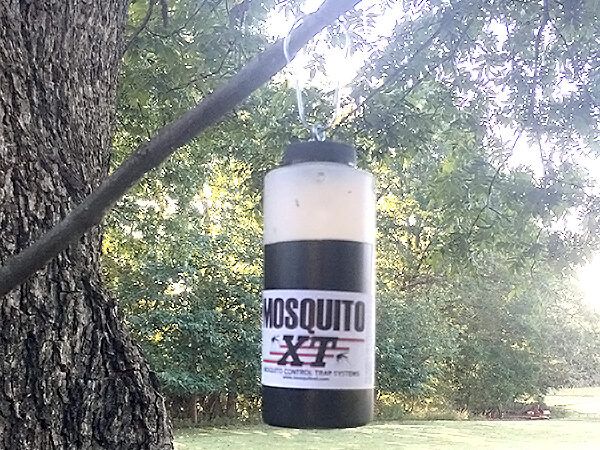
5. Spartan Mosquito Pro Tech
This device is uses boric acid instead of salt as active ingredient, but still contains sugar and yeast (both as unlisted, inactive ingredients). Company says tubes kill mosquitoes for up to 30 days. California banned it after reviewing efficacy data. I reviewed it in 2020. Here’s the inventor, Jeremy Hirsch, on a 25-min Q&A with one of the retailers (note that video glitches out several times):
6. Aion Mosquito Barrier
Company says the tubes “kill and repel” mosquitoes for 90 days. Contains sugar, yeast, and table salt. It was first marketed as The Mosquito Eradicator (picture below). Based in Memphis, TN. Website. Here’s an ad:
7. Skeeter Hawk Backyard Bait Station
Contains sugar, yeast, citric acid, calcium carbonate, and garlic oil. Based in Grand Prairie, TX (details). Below is an ad:
8. Grandpa Gus’s Mosquito Dynamiter
Company claims the device will eradicate up to 95% of mosquitoes for up to 90 days and asserts that mosquitoes “literally explode”. Contains sugar, yeast, and table salt. Made by Vic West Imports of Austin, TX. UPDATE: they’ve stopped making this.
9. Tougher Than Tom’s Mosquito TNT
Owned by Simply Strive (Zachary Collins) of Austin, Texas. Here’s my blog post on the device. And here’s a review by somebody on YouTube.
10. Solution X
Per the box, “clears away 95% of mosquitoes.” Based in Memphis, TN (details). Parent company is EnviroChem, a distributor of cleaning compounds. I couldn’t find a commercial or a website but here’s the box layout that they send to state pesticide regulators:
11. Greenerways Mosquito-Bite FreeZone
Claims to lure mosquitoes and then jam their receptors, creating a mosquito-free area with 100-foot radius for seven days. Lists soybean oil as the active ingredient, but also has sucrose, yeast, and essential oils. Available on Amazon and many other online retailers. Greenerways LLC is based in Yardley, PA. Here’s a video ad (screenshot below).
Do they work?
To my knowledge, there’s no evidence that any of the above devices kill or repel mosquitoes when they are deployed outside. There’s evidence they don’t work, though. For example, scientists in Florida tested the Spartan Mosquito Eradicator and concluded it wasn’t effective. And scientists have also established that salt water doesn’t kill mosquitoes, so all the devices that list sodium chloride as the active ingredient (most of them) are not going to work at all. Finally, in my testing of the Spartan Mosquito Pro Tech, mosquitoes are not even attracted to the containers, which, if generalizable to the other products, makes it unlikely these products would do anything even if they had an active ingredient (like boric acid) that is lethal mosquitoes.
Here are photographs showing what is inside a Spartan Mosquito Eradicator (left) and a Spartan Pro Tech (right) after several weeks. Plenty of picture-wing flies, fruit flies, ants, and molds. But no mosquitoes. I’ve never even seen a mosquito come near these tubes.
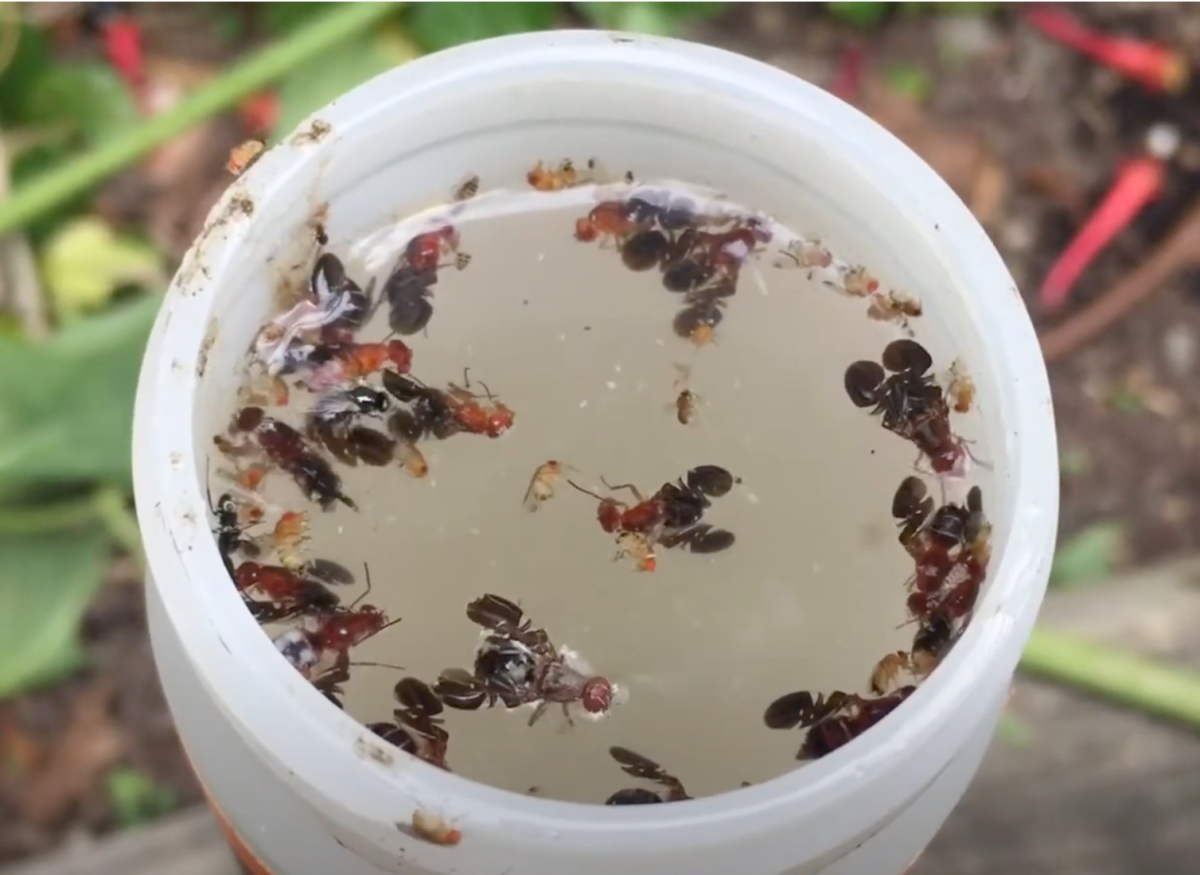

If you’d like to see the full array of insects and spiders that these tubes killed, I’ve collected them on iNaturalist.
Why are these companies still in business if their products don’t kill mosquitoes?
I think there are four reasons.
- Towns, municipalities, and regional health departments often spray adulticides from trucks and airplanes, in the middle of the night, without many residents being aware. And if some of those people have yeast-and-sugar tubes hanging in their yards, they might wrongly assume the lack of mosquitoes is related. This scenario is probably common because spraying happens pretty much at the exact time of the year that homeowners place the yeast-and-sugar containers around their yards. For those curious about Mosquito Abatement Districts, this article has a nice summary. You can also ask your local government for details on whether your house is being treated.
- Sometimes due to sudden and extended drought conditions, mosquito populations plummet. Again, people might not appreciate that the lack of water is preventing mosquitoes from completing their life cycle and will mistakenly attribute the drop to yeast-and-sugar devices they deployed around their yards.
- Many of the companies encourage homeowners to hang the tubes before the start of the mosquito season. It might seem to some that the tubes are keeping the mosquitoes at bay but in reality it’s because the mosquito season hasn’t started.
- Finally, some homeowners spray pyrethroid-based insecticides (like those used by Mosquito Shield and the like) in addition to deploying the yeast-and-sugar contraptions. I’ve seen comments on the internet suggesting that these people believe both are necessary even though in reality the tubes are merely decorative.
Once a person becomes convinced that the tubes work, they are unlikely to abandon that belief even when presented with clear evidence to the contrary. That’s probably especially true if a person tells multiple neighbors that the devices work. I.e., a person becomes personally invested in that belief. Indeed, when the tubes fail in future summers (or during gaps in municipal spraying), true fans of these tubes go to great lengths to blame themselves. For example, they might say, “I don’t think I used the correct temperature of water”, “I may have placed them too close to my house”, or “I should have used a few more tubes.” The companies use the same lines in response to consumer complaints, never acknowledging that the failure is with the tubes themselves.
It’s also worth pointing out that the majority of people who try these tubes conclude that they are ineffective and never buy them again. They lose $50 bucks, or whatever, and chalk it up as a mistake and get on with their lives. Some might pursue a refund but I think most people are too lazy to ask. One of the companies, Spartan Mosquito, even sets its return window to expire 30 days after product is delivered, not after 30 days of use — for a product that is supposed to kill mosquitoes for 30 days, that’s a pretty clever way to make sure nobody can get their money back. I.e., if people try it for 30 days and conclude it’s a garbage product, the return window is already over. And the companies still make a profit because the core subset of true believers (several million Americans in total) will keep spending hundreds of dollars each summer on new tubes. That’s enough to make the owners of these companies millionaires, and explains why more and more people are getting into the market.
People often mention that the reviews for these types of tubes are generally high, and use that fact to argue that the products must, in fact, work. For example, the Spartan Mosquito Pro Tech has a 4/5 rating on Amazon. I’m of the opinion, however, that even completely useless products can get ratings like that. For example, OFF! citronella candles get a rating of 4.2 even when “not intended to repel mosquitoes” is prominently displayed on the packaging (that’s correct: citronella candles do not repel mosquitoes).
Please consider sharing this post on Facebook or Nextdoor so that your friends and neighbors don’t get sucked into the scam.

